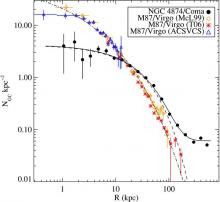
Abstract
Abstract: Intracluster stellar populations are a natural result of tidal interactions in galaxy clusters. Measuring these populations is difficult, but important for understanding the assembly of the most massive galaxies. The Coma cluster is one of the nearest truly massive galaxy clusters, and is host to a correspondingly large system of globular clusters (GCs). We use imaging from the HST/ACS Coma Cluster Survey to present the first definitive detection of a large population of intracluster GCs (IGCs) that fills the Coma cluster core and is not associated with individual galaxies. The GC surface density profile around the central massive elliptical galaxy, NGC 4874, is dominated at large radii by a population of IGCs that extend to the limit of our data (R<520 kpc). We estimate that there are 47000+/-1600 (random) +4000/-5000 (systematic) IGCs out to this radius, and that they make up ~70% of the central GC system, making this the largest GC system in the nearby Universe. Even including the GC systems of other cluster galaxies, IGCs still make up ~30-45% of the GCs in the cluster core. Observational limits from previous studies of the intracluster light (ICL) suggest that the IGC population has a high specific frequency. If the IGC population has a specific frequency similar to high-S_N dwarf galaxies, then the ICL has a total stellar mass of ~10^12 M_sun within the cluster core. The ICL makes up approximately half of the stellar luminosity and one-third of the stellar mass of the central (NGC4874+ICL) system. The color distribution of the IGC population is bimodal, with blue, metal-poor GCs outnumbering red, metal-rich GCs by a ratio of 4:1. The fraction of red IGCs (20%), and the red color of those GCs, implies that IGCs can originate from the halos of relatively massive, L* galaxies, and not solely from the disruption of dwarf galaxies.